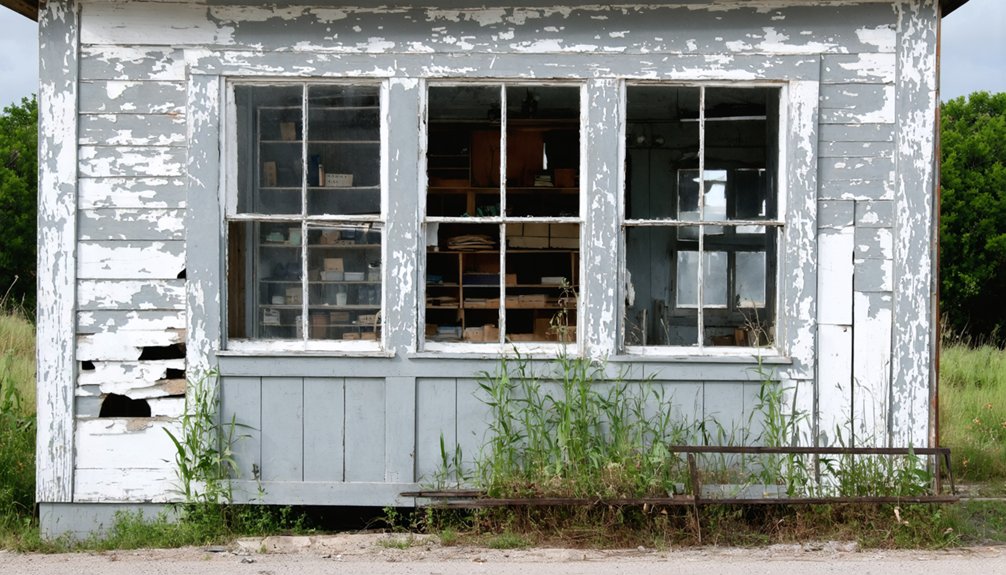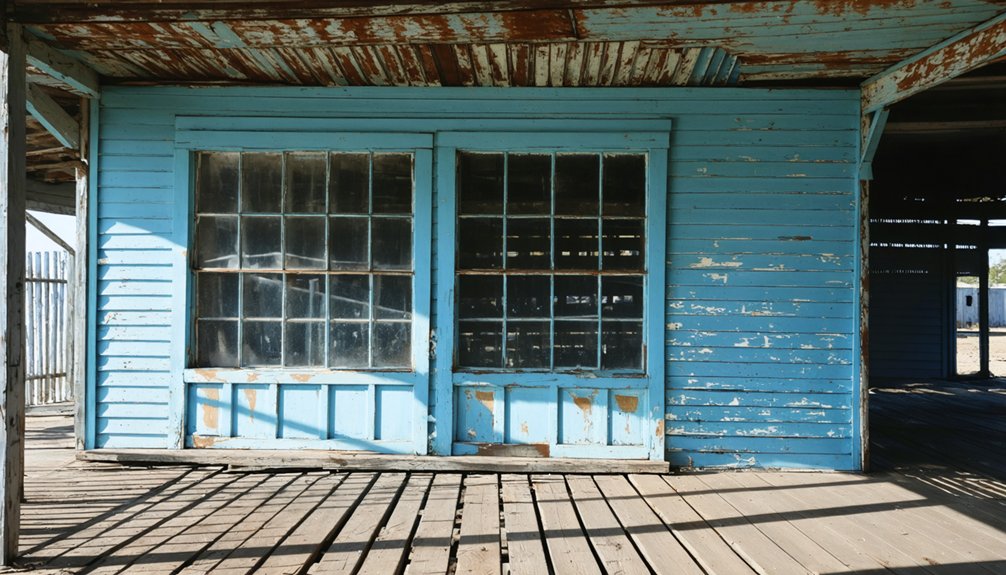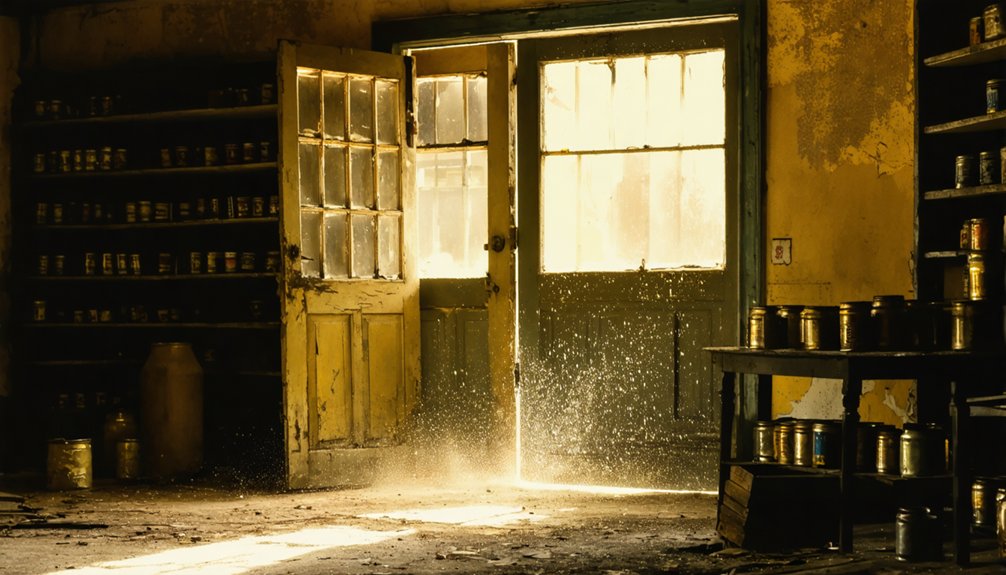You’ll find Olga nestled in southern Nolan County near the Coke County line, where the Texas Rolling Plains stretch across sandy loam soils. This former farming community centered around its church, schoolhouse, and general store, with daily life revolving around crops and livestock. While time hasn’t been kind to Olga’s structures, scattered remnants and weathered buildings still dot the landscape, offering glimpses into a once-thriving rural settlement’s story that awaits exploration.
Key Takeaways
- Olga was a small settlement in southern Nolan County, Texas, characterized by dryland farming and grazing on sandy loam soils.
- The community centered around essential gathering places like the general store, church, schoolhouse, and local marketplaces.
- Daily life revolved around agricultural activities, with residents working from sunrise to sunset managing crops and livestock.
- Few original structures remain today, with weathered remnants of homes, churches, and schoolhouses scattered across the landscape.
- The site lacks formal archaeological studies and faces preservation challenges due to private ownership and unauthorized artifact collection.
The Rise and Fall of a Texas Settlement
When settlers first discovered Van Horn Wells in the mid-19th century, they recognized the critical importance of this rare water source in the arid West Texas landscape.
You’ll find that this crucial stop along the San Antonio-El Paso Road quickly became essential for westbound travelers, with mail routes and the Southern Pacific Railroad establishing operations by 1882.
The town, later named Lobo, thrived initially with steady growth, reaching about 20 residents by 1915. For clarity in historical records, the name “Lobo” requires disambiguation from other locations and references sharing this designation.
Like the coal miners of Thurber who were paid with company store scrip, the residents of Lobo faced their own economic constraints.
However, devastating earthquakes in 1929 and 1931, followed by increasing water scarcity, sparked its eventual downfall.
Natural disasters and dwindling water resources dealt the fatal blow to Lobo’s fragile existence in early 20th century Texas.
As the water table dropped dramatically, irrigation costs soared, forcing the closure of the cotton gin and railroad stop.
This economic decline led to Lobo’s complete abandonment by 1991, transforming a once-promising settlement into another reflection of the harsh realities of frontier life.
Location and Geographic Features
Nestled in southern Nolan County near the Coke County line, Olga’s location typifies the stark beauty of West Texas’s semiarid landscape.
You’ll find yourself surrounded by the Texas Rolling Plains, where grasslands stretch across flat to rolling terrain dotted with hardy mesquite trees. The sandy loam soils once supported dryland farming and continue to serve as grazing land today.
Geographic isolation played a significant role in Olga’s destiny. Without major roads or rail connections, the settlement remained off the beaten path. Like many settlements documented in Bartholomew’s ghost town encyclopedia, Olga gradually faded into history. Similar to the town of Bartonsite, most structures were eventually relocated.
Today, you’ll need to navigate local roads to reach this ghost town’s former location. The land use has shifted primarily to ranching, and while there’s little remaining infrastructure, the open prairie vista offers a glimpse into the challenges early settlers faced in this remote corner of West Texas.
Historical Timeline and Key Events
The historical record of Olga remains largely shrouded in mystery, with few documented events or milestones to mark its brief existence.
While you won’t find specific dates or turning points in Olga’s timeline, its significance as a Texas ghost town mirrors the pattern of many similar communities that faced environmental and economic challenges.
Like other abandoned settlements, Olga’s story likely includes the familiar elements of water scarcity, shifting economic conditions, and the powerful influence of railroad development that shaped many Texas towns’ destinies. The decline of such towns often followed the pattern seen in Lobo, where water table depletion led to agricultural collapse and eventual abandonment.
Understanding Olga’s ghost town characteristics requires examining parallel examples in Texas history, where communities often struggled with drought, agricultural difficulties, and changing industrial landscapes before their eventual abandonment.
Life in Early Olga
If you’d lived in early Olga, you’d have started your day before sunrise tending to crops and livestock, following seasonal agricultural routines that sustained the community.
You would’ve gathered with neighbors at local stores and marketplaces to trade goods, share news, and maintain social bonds essential to the town’s survival. Like many of the 511 ghost towns across Texas, Olga’s residents relied heavily on community connections.
Your daily interactions would’ve centered around community gathering spots like the general store, where farmers exchanged their cotton and corn harvests for necessary supplies while catching up on local happenings. Similar to the settlement of Cannonville, the town developed along wagon routes that connected major regional destinations.
Daily Agricultural Routines
During Olga’s early farming days, agricultural routines revolved around intensive manual labor from sunrise to sunset, with families working together to maintain their cotton fields and livestock.
You’d start your day by tending to essential crop management tasks – plowing, planting, or harvesting cotton depending on the season. While men tackled the heavier fieldwork, women and children contributed by maintaining vegetable gardens and preserving food supplies.
Livestock care demanded constant attention, from feeding cattle to monitoring their health and moving herds to fresh grazing areas. You’d rely on basic tools like plows and hoes, making repairs as needed to keep operations running. Many farmers faced challenges similar to those in Goforth, where soil exhaustion severely impacted crop yields.
When rain was scarce, you’d carefully manage well water for both crops and animals, similar to how the residents of Van Horn Wells became the region’s primary water source. Community cooperation through labor sharing helped everyone survive the demanding farming lifestyle.
Community Gathering Places
Despite its small size, Olga fostered a vibrant community life centered around several key gathering places that shaped daily social interactions.
You’d find the heart of town life at the community hall, where weddings, town meetings, and harvest festivals brought neighbors together, strengthening social bonds through shared experiences. Similar to how J. Lorraine’s horseshoes provided entertainment for residents, these activities created lasting memories.
The local church served as both a spiritual center and a hub for charitable works, while the schoolhouse hosted educational activities and community events that united families.
A general store and post office provided more than just goods and services – they created spaces where you could catch up on local news and maintain connections with fellow residents.
Even the town’s modest public spaces, maintained by dedicated volunteers, offered areas where you could gather for picnics and outdoor celebrations.
Local Trading Activities
The vibrant community spaces of early Olga naturally gave rise to a rich network of local trading activities. The post office, operating from 1892 to 1910, served as the heart of these trading traditions, where you’d find residents exchanging news alongside goods.
Local marketplaces sprouted up around farmers’ gathering spots and general stores, creating a self-sustaining economic ecosystem.
Here’s what you’d typically find traded in early Olga:
- Farm-fresh produce and livestock from local agricultural operations
- Handcrafted items like textiles, tools, and household goods
- Essential foodstuffs including preserved meats and dairy products
- Agricultural equipment and farming supplies
Through these trading networks, Olga’s residents maintained their independence while fostering strong community bonds, connecting with neighboring towns through established regional trade routes and postal services.
What Remains Today
Modern-day visitors to Olga will find only a handful of original structures still standing, having succumbed to decades of natural decay and neglect.
You’ll discover weathered remnants of what were once homes, churches, and schoolhouses scattered across the rural landscape. Historical markers dot the area, offering glimpses into the town’s past while abandoned structures slowly return to the earth.
The surrounding environment has largely reclaimed the settlement, with native Texas vegetation growing freely among the ruins.
You’ll notice open fields and pastures where farming once thrived, while nearby creeks and natural features remain unchanged from the town’s heyday.
Local historical societies occasionally maintain some sites, though most structures continue their slow deterioration, serving as silent testimonials to Olga’s once-vibrant community.
Preservation Challenges and Documentation

You’ll find that documenting Olga’s history presents significant challenges due to limited historical records and the absence of thorough archaeological studies.
The physical deterioration of the site has accelerated over time, with natural elements and neglect taking their toll on any remaining structures or artifacts.
The lack of formal preservation efforts or systematic documentation makes it increasingly difficult to piece together the complete story of this once-thriving Texas community.
Limited Historical Records
Due to sparse historical documentation, researchers studying Olga, Texas face significant challenges in piecing together the town’s complete story.
The historical significance of this ghost town risks being lost without proper record preservation efforts.
You’ll find these key challenges affecting our understanding of Olga’s past:
- Many official documents and newspapers from the area remain scattered across various archives or have been lost entirely.
- Local oral histories, while valuable, can’t always be verified against written records.
- Private collections of photographs and documents are often inaccessible to researchers.
- Environmental damage and deterioration have impacted the few surviving physical records.
These limitations mean you’re getting an incomplete picture of Olga’s history, though dedicated historians continue working to uncover and preserve what remains.
Physical Site Deterioration
While time steadily erodes Olga’s remaining structures, this once-vibrant Texas town faces mounting preservation challenges.
You’ll find the site maintenance issues are particularly severe due to the town’s remote location and limited resources. Environmental impact from wind, rain, and natural erosion continues to take its toll on the remaining buildings, while wildlife has claimed many abandoned structures as their own.
The town’s deterioration isn’t just a result of nature’s forces. The lack of regular upkeep, combined with occasional vandalism, accelerates the decay.
Without proper infrastructure and funding, preservation efforts remain difficult to implement. However, architectural surveys and detailed mapping initiatives are underway to document what’s left of Olga’s physical heritage, ensuring that even if structures can’t be saved, their history won’t be lost.
Missing Archaeological Studies
Despite its historical significance, Olga remains largely unexplored from an archaeological perspective, creating substantial gaps in scholarly understanding of the site.
The lack of thorough site documentation has severely limited our ability to piece together the area’s rich history and archaeological significance.
Key challenges affecting proper archaeological study include:
- Limited access to the site due to private ownership issues, preventing systematic research and professional excavation.
- Absence of modern archaeological technologies like ground-penetrating radar and GIS mapping, which could reveal hidden features.
- Extensive damage from unauthorized artifact collecting and looting, disrupting the site’s archaeological integrity.
- No formal published studies or detailed stratigraphic recordings, making it difficult to establish accurate dating and cultural context.
Legacy Among Texas Ghost Towns

Among the hundreds of ghost towns scattered across Texas, Olga stands as a modest example of rural community decline rather than a dramatic tale of boom and bust.
You won’t find the dramatic narratives or folklore that often characterize more prominent ghost towns like Indianola or Fort Griffin. Instead, Olga’s story reflects the broader economic shifts that transformed rural Texas during the mid-20th century, as mechanization and urbanization drew residents away from agricultural communities.
Unlike its better-known counterparts, Olga hasn’t left a significant mark on Texas’s cultural memory.
You’ll find no tourist attractions, preserved buildings, or interpretive signs marking its history. What remains is simply a quiet representation of the countless small communities that once dotted the Texas landscape, their stories largely lost to time.
Frequently Asked Questions
Were There Any Local Legends or Ghost Stories Associated With Olga?
Despite diving deep into haunted history and local folklore, you won’t find documented ghost stories connected to Olga. The town’s mysteries remain locked in time, taking its secrets when it vanished.
What Natural Disasters or Extreme Weather Events Affected Olga During Its Existence?
You’ll find that drought impact greatly affected local agriculture and water supplies, while Texas’s typical flood damage likely challenged the community, though specific records of major disasters aren’t documented.
Did Any Famous Outlaws or Historical Figures Ever Pass Through Olga?
Like a blank page in history’s book, you won’t find any documented outlaw encounters or historical figures passing through Olga. Historical records don’t show any famous visitors to this small settlement.
What Were the Most Common Occupations of Olga’s Residents?
You’d have found most residents working as farmers, using traditional farming techniques, while others raised cattle or ran local stores. They’d gather for community events between their daily labors.
Are There Any Surviving Photographs of Olga During Its Prime Years?
You’d have better luck finding a unicorn’s selfie! Despite searching photographic archives and historical documentation, there’s no concrete evidence of surviving photos from Olga’s prime years between 1892-1910.
References
- https://www.youtube.com/watch?v=Ux4FjzHs5DE
- https://discovertexasoutdoors.com/places/olga/
- https://texashighways.com/travel-news/four-texas-ghost-towns/
- https://jamesbigleyranches.com/general/texas-ghost-towns/
- https://www.southernthing.com/ruins-in-texas-2640914879.html
- https://en.wikipedia.org/wiki/List_of_ghost_towns_in_Texas
- https://www.texasescapes.com/TexasGhostTowns/OlgaTexas/OlgaTexas.htm
- https://www.texasescapes.com/TOWNS/Texas-Ghost-Towns-5-Texas-Panhandle.htm
- https://en.wikipedia.org/wiki/Lobo
- https://www.youtube.com/watch?v=phjUE19A8HM



